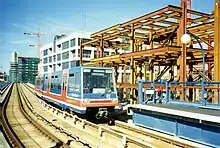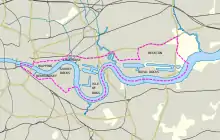 | |
| Formation | 1981 |
|---|---|
| Dissolved | 1998 |
| Headquarters | London |
Official language | English |
Chairmen |
|
Key people |
|

The London Docklands Development Corporation (LDDC) was a quango agency set up by the UK Government in 1981 to regenerate the depressed Docklands area of east London.[1] During its seventeen-year existence, it was responsible for regenerating an area of 8.5 square miles (22 km2) in the London Boroughs of Newham, Tower Hamlets and Southwark. LDDC helped to create Canary Wharf, Surrey Quays shopping centre, London City Airport, ExCeL Exhibition Centre, London Arena and the Docklands Light Railway, bringing more than 120,000 new jobs to the Docklands and making the area highly sought after for housing. Although initially fiercely resisted by local councils and residents, today it is generally regarded as having been a success and is now used as an example of large-scale regeneration, although tensions between older and more recent residents remain.
Reason for creation
London's Docklands were at one time the largest and most successful in the world. Starting with West India Docks in 1802, East India Docks, Millwall Dock, Surrey Docks and then the Royal Docks, thousands of people were employed in international trade, warehousing and related trades. Over time, manufacturing industry also moved into the Docklands, including large coal and gas plants and storage, flour mills and many other businesses.[2]
During World War II, the docks area was heavily bombed during the Blitz, in an attempt to destroy the British economy. This crippled or damaged much of the infrastructure and many older buildings were lost or no longer used.[3]
There was a brief resurgence during the 1950s but the docks were empty by 1980. The main reason was containerisation: goods used to be brought into the UK by relatively small ships, unloaded by hand; from the 1970s onwards most trade was carried within intermodal containers (shipping containers) or by truck on roll-on/roll-off ferries.[4]
Between 1961 and 1971, almost 83,000 jobs were lost in the five boroughs in the Docklands area (Greenwich, Lewisham, Newham, Tower Hamlets and Southwark). A large percentage of these jobs were from large transnational corporations. The decline was heightened by government policies which favoured the growth of industry outside London.[5]
The housing in the Docklands area was nearly all council-owned terraced housing and flats. There was no commercial infrastructure such as banks or building societies or any new office accommodation.[6]
Formation
The London Docklands Development Corporation was established by the then Secretary of State for the Environment, Michael Heseltine, under section 135 of the Local Government, Planning and Land Act 1980. It was financed by a grant from central government and from the proceeds from the disposal of land for development.[7]
The corporation acted as a catalyst benefiting from the full range of planning authority powers (principally those of development control).[7]
Additionally, the Government set up an Enterprise Zone with certain tax breaks in the area.[8]
Operation 1981-1994

LDDC's first chief executive was Reg Ward, a former chief executive of Hereford and Worcester County Council and Hammersmith and Fulham London Borough Council.[9] Ward said if he had created some grand plan..."we would still be debating and nothing would have got built. Instead, we have gone for an organic, market-driven approach, responding pragmatically to each situation."[9]
Billingsgate Market had already relocated from the City to Docklands, and this was thought to be typical of the type of industry which might be accommodated.[10]
However, Docklands was close to the City of London and this made it an attractive secondary office location as well as a possible site for riverside residential development to accommodate the phenomenon of yuppies, the young high-income single-person households created by new jobs in the financial services industry. In the first few years of LDDC's operation several offices and flats schemes were given the go ahead including on Heron Quays and Surrey Quays. Many of these buildings demonstrated unique architecture, such as the Baltic Quay building in the Surrey Docks.[11]
LDDC's success was due to seizing opportunity and making maximum use of its assets. When faced with a large amount of redundant railway infrastructure, the LDDC created a cheap light rail scheme, the Docklands Light Railway to make use of it. This in turn made the whole area more accessible to the public and helped create the conditions for further development.[12]
When American/Swiss banker Michael von Clemm visited West India Docks looking for a restaurant site, he became interested in the idea of building a back office. Reg Ward jumped on this and the resulting scheme became the successful Canary Wharf development.[13][14] This development far exceeded initial projections for growth in the Royal Docks, and Canary Wharf developer Olympia and York proposed an extension of the Jubilee line to serve the site. Beginning construction in 1993, the Jubilee Line Extension opened in 1999 after the end of the LDDC.[15]
The LDDC tapped into the boom in air travel by creating a small business airport making use of the vast open spaces of the Royal Docks. London City Airport became a fast-growing and popular airport.[16]
During the 1980s private housing was developed in Docklands which with some minor exceptions were the first to be built in the area. Soon many people from outside the area saw the opportunity of buying a house close to the city at what appeared to be cheap prices. On many of the developments, local council tenants were given first opportunities to buy at discounted prices, but this led to a number of abuses.[17]
Effects outside London
The success of the LDDC spurred the government to set up similar bodies elsewhere, for example in Merseyside (1981) and later the Black Country, Cardiff Bay, Trafford Park (Greater Manchester) (all 1987), and the Central Manchester Development Corporation (1988).[18]
Undemocratic nature
One feature of the LDDC was that it was "insulated" from the local democratically elected councils.[19] Eddie Oliver, Deputy Chief Executive (1981–87)[20] agreed that it was undemocratic, explaining that it was an extraordinary arrangement for an extraordinary situation".[19]
Withdrawal 1994–1998
The LDDC began a staged withdrawal in 1994. It withdrew from Bermondsey in 1994, followed by Beckton in 1995, the Surrey Docks in 1996, from Wapping, Limehouse and the Isle of Dogs in 1997, and finally from the Royal Docks in late 1998. Under a process called "dedesignation" the powers it held reverted to the London boroughs. It was formally wound up on 31 March 1998.[21]
See also
- London Thames Gateway Development Corporation, a similar development corporation operating in Thames Gateway between 2004 and 2013
- London Legacy Development Corporation, a similar development corporation in the aftermath of the 2012 Olympic and Paralympic Games
- Cascades, Isle of Dogs
References
- ↑ LDDC History Pages – Home Page
- ↑ PortCities London. "Flour milling and the port". PortCities UK. Retrieved 12 June 2010.
- ↑ "Docklands and the Blitz". Port Cities. Archived from the original on 29 April 2021. Retrieved 14 June 2020.
- ↑ McGough, Roger (Narrator), McAulay, Graeme (Director & Producer), Crossley-Holland, Dominic (Executive Producer) (2010). The Box that Changed Britain. BBC4 (documentary). BBC.
- ↑ Medina, Carmen Díez; Monclús, Javier (2018). Urban Visions: From Planning Culture to Landscape Urbanism. Spring. p. 125. ISBN 978-3319590462.
- ↑ Hobhouse, Hermione (1994). "'Public Housing in Poplar: The 1940s to the early 1990s', in Survey of London: Volumes 43 and 44, Poplar, Blackwall and Isle of Dogs". London: British History Online. pp. 37–54. Retrieved 14 June 2020.
- 1 2 "London Docklands Development Corporation (Area and Constitution) Order 1980". Hansard. 1 July 1981. Retrieved 14 June 2020.
- ↑ "The Isle of Dogs Enterprise Zone Designation Order 1982". Legislation.gov.uk. Retrieved 14 June 2020.
- 1 2 Obituary: Reg Ward, The Daily Telegraph, 12 January 2011
- ↑ Shaffi, Sarah (28 July 2011). "Billingsgate Market rent paid in fish". East London Advertiser. Retrieved 8 June 2014.
- ↑ "Our History". Baltic Quays. Retrieved 8 June 2014.
- ↑ Cross, David (1 September 1987). "Enthusiasts flock to busy opening day: Docklands Light Railway". The Times. London.
- ↑ "Heron Tower becomes tallest building in The City". BBC News. 21 February 2010. Retrieved 11 November 2010.
- ↑ "United Kingdom list of tallest buildings". SkyscraperPage.com. Retrieved 12 January 2009.
- ↑ "Jubilee line facts". Transport for London. Archived from the original on 12 February 2008.
- ↑ "London City Airport bought for £2bn by Canadian-led group". BBC News. 26 February 2016. Archived from the original on 28 February 2016. Retrieved 26 February 2016.
- ↑ Ambrose, Peter (1994). Urban Process and Power. Routledge. p. 8. ISBN 978-0415008518.
- ↑ Impact of Urban Development Corporations in Leeds, Bristol and Central Manchester, DETR, 1998.
- 1 2 Brindley, Tim; Rydin, Yvonne; Stoker, Gerry (2005). Remaking Planning: The Politics of Urban Change. Routledge. ISBN 978-1-134-85900-9.
- ↑ "LDDC History Pages - Veteran's Page". lddc-history.org.uk. The Innes Partnership. Retrieved 14 June 2020.
- ↑ "The Urban Development Corporations in England (Dissolution) Order 1998". www.legislation.gov.uk. Retrieved 28 August 2018.